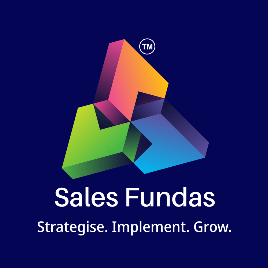Do not let this mismatch stunt your business growth.
- Jayant Kelkar

- Sep 8, 2022
- 4 min read
Updated: Nov 27, 2024

Any company that is growing will go through different stages of the business cycle and face a variety of sales & marketing issues that demand different strategies and approaches.
For instance, when it comes to market penetration, business expansion, and maintaining market share, the company will need a distinct sales & marketing approach.
Operations and priorities will alter as the company grows, necessitating a flexible approach to your sales & marketing strategy, which should integrate with your entire company's growth strategy in your annual business plan.
1. Development/Seed Stage - It can be challenging at this point to decide which sales & marketing channels will work best for your goods or services. You should learn a lot from your feasibility study about the types of advertising channels that your prospective competitors find compelling. Your marketing plan should be able to be built with the help of this research, and it should take the perspective of the customer into account. For a fully customer-centric strategy, adhere to the 4Cs model:
Customer value - Your position in the market or sector is influenced by the value you offer.
Cost - Assess what the customer should pay rather than the price.
Communication - Customers must be engaged in meaningful and rewarding relationships.
Convenience - You need to figure out why customers pick you and make it easy for them because they are busy and have many options.
2. Startup Stage - Your business idea is worth pursuing, according to the results of your feasibility study, therefore you've created a business plan. The items or services your company offers have been fully developed, and you are now ready to start marketing and selling them. You will be making adjustments to your goods or services throughout this phase in response to the initial input from your first paying clients and market demand. To ensure profitability and that your company model matches your customers' expectations, you will need to study and adapt it. You may put your company on the right path by changing your business model.
It is more expensive for a business to introduce a new product or service at this early point of the cycle. Sales of the goods may be minimal, though hopefully, they will increase if the market is tiny. On the other hand, the cost of R&D, customer testing, and marketing to introduce the product or service can be very high, particularly if it is in a highly competitive industry.
3. Growth/Survival Stage - Your company is currently in its growth or survival stage after making it through the early stages of the business lifecycle. The company is continually bringing in money through sales and bringing in new clients. Your running costs will be funded by this regular income, providing new business possibilities. There will always be competition, whether your business is making a healthy profit or a net loss right now. Before extending your endeavor to the mass market, now is a fantastic opportunity to polish your business plan and put into practice tested methodologies, sales models, marketing models, and operations models.
At this point, similar offerings from competitors are enticing them into the market. Pricing needs to remain constant as demand grows. In addition to possible additions of new features and support services, product or service quality must be sustained. As the demand for a product or service rises and consumers accept it, distribution channels could be added. A broader audience should now be the focus of sales & marketing.
4. Expansion/Rapid Growth Stage - You have reached the point where your firm will grow and spread its roots into new markets and distribution channels now that it is a successful enterprise and has made its presence known in the market. You must increase your market share and generate new revenue if you want to start profiting from your company's success. Therefore, the sales and cash flow of your company will increase quickly. The tested sales model, marketing model, and operations model described in your business plan created at the growth/survival stage are utilized in the rapid growth stage.
Sales and profits often increase significantly during the expansion stage, and because the business can now start to take advantage of operational economies of scale, both the profit margins and the total amount of profit will rise. As a result, firms can spend more money on promotional efforts, to fully use this growth stage.
5. Maturity Stage - Your company has developed and is at the top of its industry after successful growth. Your company is at the pinnacle of its business lifecycle and is a dominant force in its industry. Even while it may not be growing as quickly as it once did, your company may still be expanding. Right now, your choices are to consider a possible exit strategy or to decide to go back to the expansion stage.
During the maturity stage, the product or service is established and the aim is now to maintain the market share you have built up. This is probably the most competitive time for most products and businesses need to invest wisely in any marketing being undertaken. You also need to consider any product or service modifications or improvements to the production process, which might give you a competitive advantage.
Every phase of the business cycle carries with it brand-new or recurring challenges. Solutions that may have worked for one stage may not be appropriate for a later stage, therefore you should constantly examine and modify your operations and business plan as necessary.
Your company will rely largely on a funding source to help it get through each stage and meet its challenges. It is crucial to have the sales & marketing strategy suitable for each stage contributing to revenue generation. Therefore, having a comprehensive business plan for the next two stages is important to anticipate potential problems, be prepared for any challenge, and make smarter business decisions to continue to grow with everything going around you in the market & industry.
If you are not sure of your answer to “Are you sure about having the right Sales & Marketing Strategy for the stage of business?”, take the free “Sales Operations Assessment”:




Comments